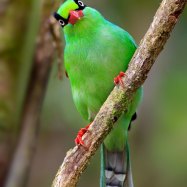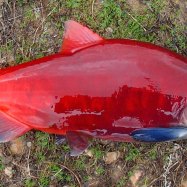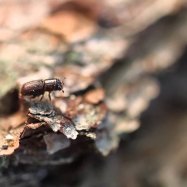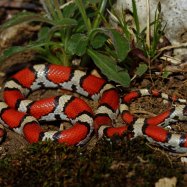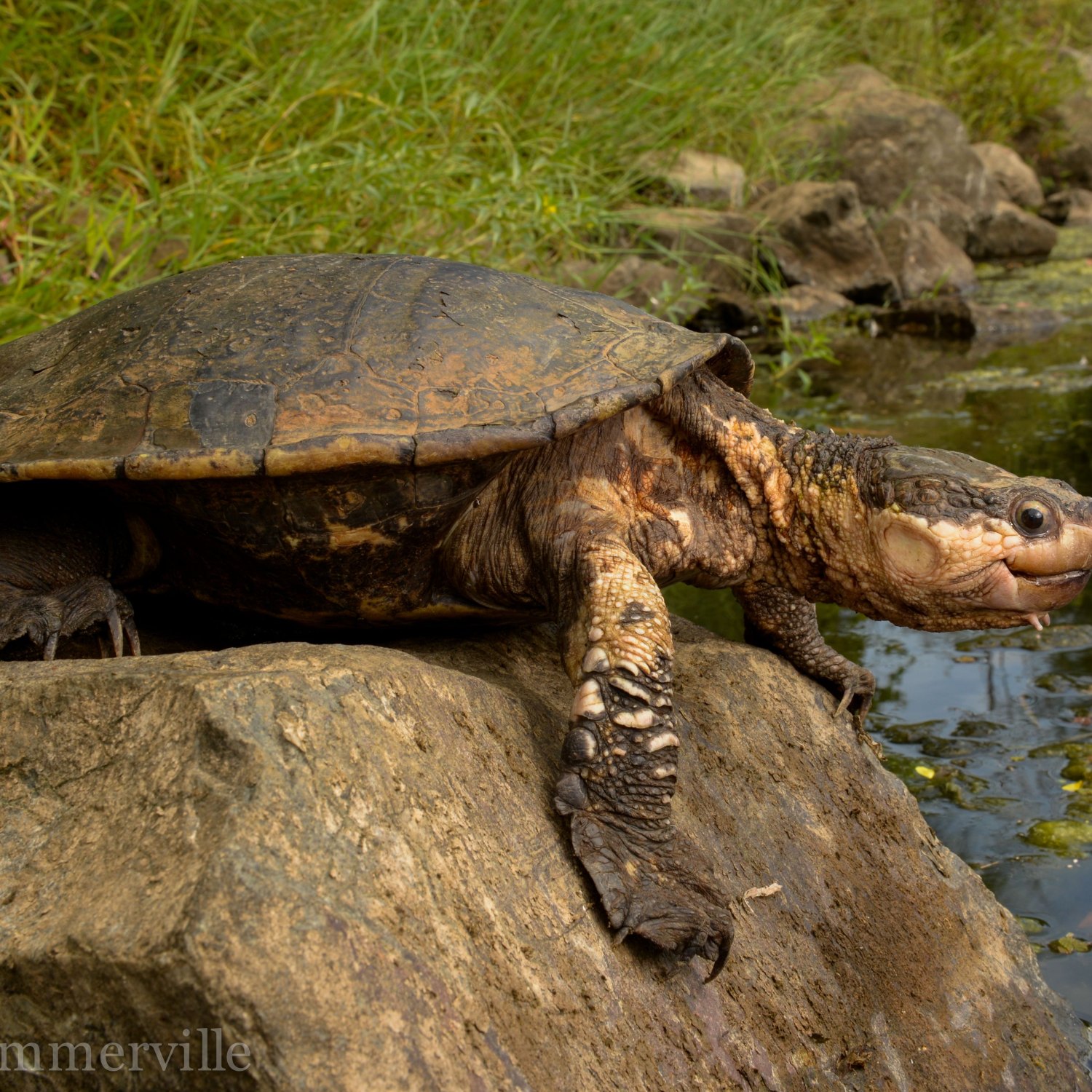
Snapping Turtle
8-20 inches (20-50 cm)
Snapping turtles have a large, heavy shell and muscular body. Growing up to 20 inches in length, these animals can be found in the Eastern United States and parts of Canada. With their strong jaws, they are formidable hunters, feeding on fish, frogs, and even small birds. Belonging to the family Chelydridae, snapping turtles play an important role in their ecosystems as scavengers and predators. Keep a safe distance when encountering them in the wild!
Animal Details Summary:
Common Name: Snapping Turtle
Kingdom: Animalia
Habitat: Freshwater habitats such as streams, rivers, lakes, ponds, and marshes
The Fierce and Fascinating Snapping Turtle
Deep in the freshwaters of North America, lives a creature that may not be the most welcoming but certainly captures our fascination – the snapping turtle. With its unique appearance and behavior, the snapping turtle is a fascinating creature that has intrigued scientists and animal lovers alike for centuries.A Brief Introduction to the Snapping Turtle
The scientific name of the snapping turtle is Chelydra serpentina, derived from the Greek words 'chelys' meaning 'tortoise' and 'drakon' meaning 'dragon'. This already gives us a glimpse into the fierce nature of this creature Snapping Turtle. It is also commonly known as the snapping turtle, which is quite fitting due to its tendency to snap and bite when threatened or disturbed.Belonging to the kingdom Animalia, phylum Chordata, class Reptilia, and order Testudines, the snapping turtle is a well-adapted reptile. It is the sole member of its family, Chelydridae, which makes it a unique and solitary creature in the animal kingdom. Let's dive into this fascinating creature and discover more about its habitat, diet, and behavior.
Habitat and Distribution
The snapping turtle is commonly found in freshwater habitats such as streams, rivers, lakes, ponds, and marshes. With its strong and sharp claws, it is well-suited for navigating through these environments. It prefers quiet, shallow waters with muddy or sandy bottoms, where it can bury itself and lay in wait for its prey.This species is native to North America, particularly the United States and Canada. Its geographical distribution includes the eastern United States and parts of Canada, where it can be found in the wild Sloth. However, they have also been introduced to other parts of the world, such as Europe and Asia, as pets or for consumption.
Feeding Habits
The snapping turtle is a carnivorous creature, which means it primarily feeds on meat. It has a diverse diet ranging from insects, fish, and frogs to small mammals, birds, and even other turtles. It is an opportunistic feeder and will consume whatever prey comes its way. This, combined with its powerful jaws and sharp beak, makes it a formidable predator in its environment.Interestingly, the snapping turtle is also known to be a scavenger, feeding on dead animals that it may come across. This behavior has often led to them being labeled as 'garbage disposals' of the freshwater ecosystem. However, this is a vital role in maintaining the balance of the ecosystem and preventing the spread of diseases.
Physical Characteristics
The snapping turtle has a distinct appearance that sets it apart from other turtles. Its body is covered with rough, sharp scales, and its head is adorned with a prominent hooked beak. It has a dark brown or black coloration, which helps it blend seamlessly into its environment and provides camouflage from potential predators.One of the most striking features of the snapping turtle is its size and weight. It has a large, heavy shell, also known as a carapace, which can range from 8-20 inches (20-50 cm) in length. The carapace is typically dark-colored and is marked with ridges that give it a rough, rugged appearance. Its muscular body, combined with its massive head, can make some individuals weigh up to 60 pounds!
Behavior and Adaptations
The snapping turtle's behavior is as fierce as its appearance. It is known for its aggressive nature and will not hesitate to snap and bite if it feels threatened. Its sharp beak and strong jaws can easily crush prey or cause serious injury to predators or humans.Not only is it aggressive, but the snapping turtle also has impressive adaptations to help it survive in its environment. It has a powerful sense of smell, thanks to its keen nostrils, which helps it detect prey underwater easily. Its shell also provides excellent protection against predators, and it can retract its head and legs inside the shell for added protection.
Interestingly, the snapping turtle is also known for its ability to hibernate for long periods in winter. It creates a burrow in the mud at the bottom of the water, burying itself and slowing down its metabolic rate to survive during the cold months.
Conservation and Threats
Despite its fierce appearance and behavior, the snapping turtle faces many threats in the wild, including habitat loss and pollution. With the destruction of wetlands and freshwater habitats, their food sources and breeding areas are also decreasing, leading to a decline in their population.Humans also pose a threat to the snapping turtle. They are often hunted for their meat, eggs, and shells, and their habitat is disturbed by human activities such as fishing and boating. Additionally, the disposal of plastic and other pollutants in the water has caused many turtles to ingest these harmful materials, leading to health issues and even death.
Interesting Facts About the Snapping Turtle
- Snapping turtles have a long lifespan, with some individuals living up to 100 years.- They are excellent swimmers and can even move on land quickly, despite their heavy shells.
- Despite being carnivorous, snapping turtles have been known to consume vegetation, such as aquatic plants and fruits.
- These turtles have a sharp sense of hearing and can produce a hissing noise when threatened.
- In Native American culture, snapping turtles are often associated with creation and are considered a symbol of courage and determination.
The Fierce and Strong Snapping Turtle
In conclusion, the snapping turtle is a unique and fascinating creature, with its fierce appearance and aggressive behavior. As human beings, it is our responsibility to protect and preserve these creatures and their habitats to ensure that they continue to thrive in the wild. With proper conservation efforts and awareness, we can ensure that the snapping turtle remains a feared and respected inhabitant of the freshwater world.

Snapping Turtle
Animal Details Snapping Turtle - Scientific Name: Chelydra serpentina
- Category: Animals S
- Scientific Name: Chelydra serpentina
- Common Name: Snapping Turtle
- Kingdom: Animalia
- Phylum: Chordata
- Class: Reptilia
- Order: Testudines
- Family: Chelydridae
- Habitat: Freshwater habitats such as streams, rivers, lakes, ponds, and marshes
- Feeding Method: Carnivorous
- Geographical Distribution: North America
- Country of Origin: United States and Canada
- Location: Eastern United States and parts of Canada
- Animal Coloration: Dark brown or black
- Body Shape: Large, heavy shell and a muscular body
- Length: 8-20 inches (20-50 cm)
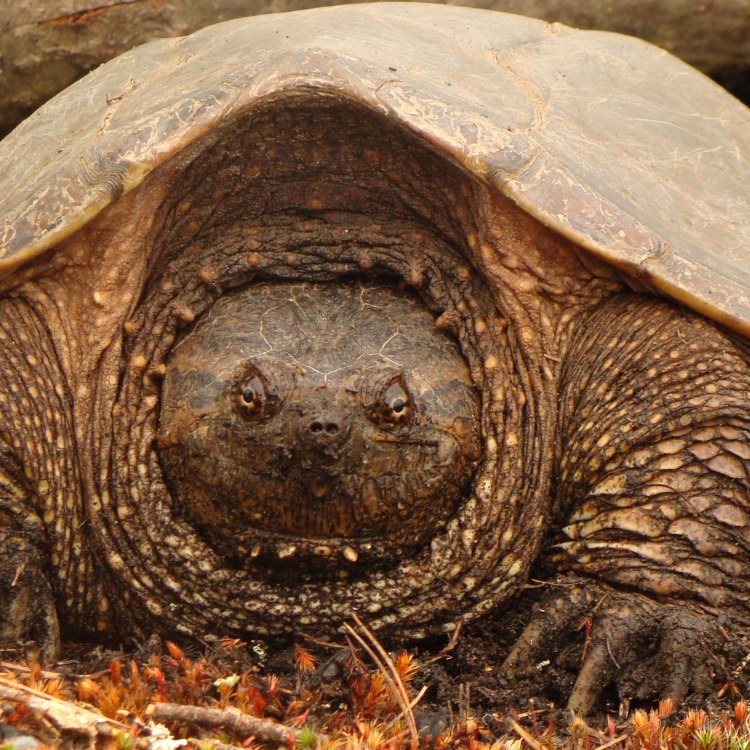
Snapping Turtle
- Adult Size: 14-20 inches (35-50 cm)
- Average Lifespan: 30-40 years in the wild
- Reproduction: Sexual
- Reproductive Behavior: Mating occurs in the water, with the male clasping the female's shell
- Sound or Call: Snapping turtles are not known for vocalizations
- Migration Pattern: Some individuals may migrate short distances to find suitable nesting sites
- Social Groups: Solitary
- Behavior: Aggressive when threatened, with a powerful bite
- Threats: Habitat loss, pollution, hunting, and collection for the pet trade
- Conservation Status: Least Concern
- Impact on Ecosystem: As top predators, snapping turtles help regulate populations of prey species
- Human Use: Harvested for their meat, shells, and eggs
- Distinctive Features: Long tail, small eyes, and a beak-like snout with a hooked upper jaw
- Interesting Facts: Snapping turtles have one of the strongest bites of any animal
- Predator: Humans, large birds, mammals, and other predatory reptiles
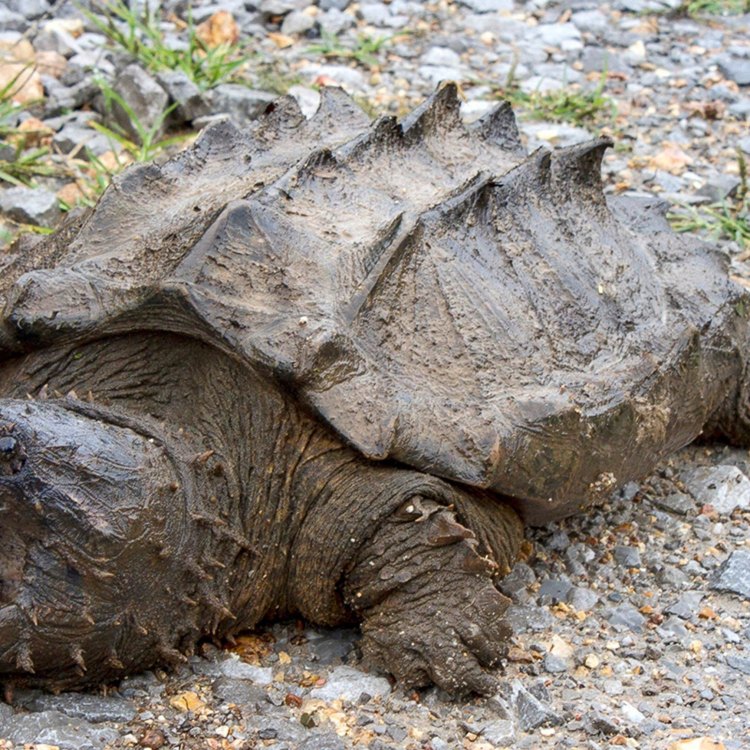
Chelydra serpentina
The Mighty Snapping Turtle: A Fierce yet Fascinating Creature
The snapping turtle, with its large size, sharp beak, and aggressive behavior, is often considered a dangerous creature. However, this fascinating reptile is an essential part of our ecosystem and plays a crucial role in maintaining its balance.Found in a wide variety of freshwater habitats, from lakes and ponds to slow-moving rivers and swamps, snapping turtles are known for their fierce nature and powerful bite. But beyond these well-known characteristics, there is so much more to discover about this unique creature PeaceOfAnimals.Com. Let's dive deep into the world of snapping turtles and explore why they deserve our admiration and protection.
Size and Lifespan
The average adult snapping turtle measures between 14 to 20 inches (35 to 50 cm) in length, making it one of the largest freshwater turtles in North America. However, they can grow up to 30 inches (75 cm) and weigh over 35 pounds (16 kg). These impressive dimensions make them the largest turtle species in the world, only surpassed by marine turtles.
Snapping turtles are long-lived creatures, with an average lifespan of 30 to 40 years in the wild. However, they have been known to live up to 100 years in captivity. Their longevity is due to their slow metabolism and sturdy bodies, allowing them to survive and thrive in harsh conditions.
Reproduction and Behavior
Snapping turtles are sexually reproducing animals, meaning they require a male and a female to mate and produce offspring. Mating typically occurs in the water, with the male clasping the female's shell and using his long claws to hold onto her Snowberry Clearwing Moth. The female then lays her eggs, burying them in the soft soil near the water's edge.
Male snapping turtles can become quite competitive during mating season, sometimes leading to aggressive behavior between them. However, these turtles are generally solitary creatures and only come together to mate.
Migratory Behavior
While some individuals may migrate short distances to find suitable nesting sites, most snapping turtles stay in their home range throughout their lives. This behavior makes them vulnerable to habitat fragmentation and loss, which can have a severe impact on their population.
Solitary Lives, But Vital Role
Unlike other turtle species, snapping turtles are solitary creatures and often prefer to keep to themselves. They are typically most active at night and spend most of their time resting on the bottom of shallow water bodies.
However, despite their solitary nature, snapping turtles play a crucial role in shaping their ecosystem. As top predators, they help regulate populations of prey species, such as fish, frogs, and small mammals. Without them, these populations could explode, leading to an unbalanced environment.
Aggressive Defense Mechanisms
Snapping turtles are known for their aggressive behavior and powerful bite. When threatened, they can extend their long necks to snap and bite their predators or humans. This behavior is their defense mechanism against potential threats, and they will not hesitate to use it if they feel threatened.
It is essential to understand that snapping turtles do not attack unprovoked and only do so as a last resort. If left undisturbed, they will avoid human contact and go about their solitary lives peacefully.
Threats to Survival
Despite their formidable appearance, snapping turtles face various threats that jeopardize their survival. Habitat loss, pollution, hunting, and collection for the pet trade are the main factors contributing to their declining population.
Loss of suitable nesting sites due to development and pollution in freshwater habitats is a significant concern for snapping turtles. The decline in water quality is also a significant threat, as these turtles are highly sensitive to pollutants and can get sick or even die from exposure.
Moreover, snapping turtles are often illegally hunted for their meat, shells, and eggs, which are considered a delicacy in some cultures. Similarly, they are also collected from the wild for the pet trade, which can have a significant impact on their population.
Conservation Status
The International Union for Conservation of Nature (IUCN) has classified snapping turtles as "Least Concern" in terms of conservation status. However, this does not mean that they are not facing threats. Their population has been declining in many areas, and they are currently listed as "Threatened" or "Endangered" in several states across North America.
To ensure their survival, it is crucial to address the threats facing snapping turtles and take steps to protect their habitat and prevent illegal hunting and collection.
Distinctive Features
Snapping turtles have several unique features that set them apart from other turtle species. These physical attributes make them easily identifiable and play a significant role in their survival.
One of the most distinctive features of snapping turtles is their long tail, which can be as long as their shell's width. This tail is used for balance and can also be used to ward off predators by snapping it as a warning sign.
They also have small eyes, making their vision limited. However, their sense of smell is highly developed, allowing them to locate food and navigate their environment effectively.
The most recognizable feature of snapping turtles is their beak-like snout with a hooked upper jaw. This sharp beak is used for catching prey and can administer a powerful bite, making it a formidable weapon.
Interesting Facts
Snapping turtles have some fascinating behaviors and abilities that add to their charm and intrigue. For instance, these turtles can stay underwater for up to 40 minutes without taking a breath, thanks to their powerful respiratory system.
They are also great survivors and can withstand very low oxygen levels in the water. Snapping turtles can even survive without oxygen for several months by slowing down their metabolism and relying on stored energy.
Moreover, snapping turtles have one of the strongest bites of any animal, with a force of over 1000 newtons. This incredible biting power makes it challenging for predators or even humans to release them once they clasp on with their powerful jaws.
Predators
Snapping turtles have relatively few predators as their large size, aggressive behavior, and powerful bite make them formidable opponents. However, humans are their biggest threat, primarily due to habitat destruction, pollution, and hunting.
Large birds, such as eagles and herons, and other predatory reptiles, such as alligators and crocodiles, are some of the few natural predators who can take on a snapping turtle.
Conclusion
The snapping turtle, with its fierce reputation and unique features, is truly a remarkable creature. Despite facing various threats to their survival, these turtles continue to play a vital role in regulating their ecosystem as top predators.
It is our responsibility to ensure the conservation and protection of snapping turtles to maintain the balance of our freshwater habitats. By understanding and appreciating these magnificent creatures, we can work towards their preservation and admire them for their strength and resilience. So, let's do our part to ensure that the mighty snapping turtle continues to thrive in our environment for generations to come.
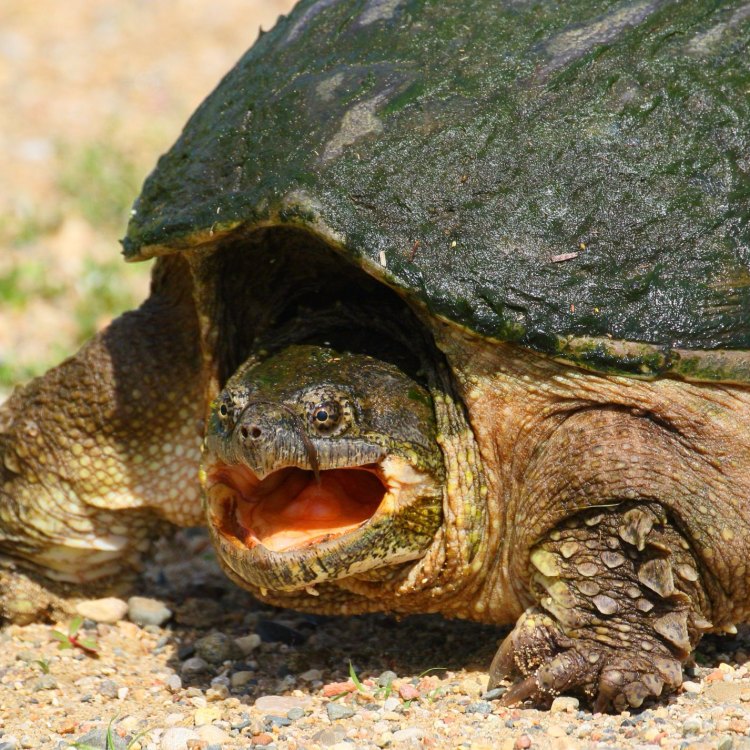
The Fierce and Fascinating Snapping Turtle
Disclaimer: The content provided is for informational purposes only. We cannot guarantee the accuracy of the information on this page 100%. All information provided here may change without prior notice.





